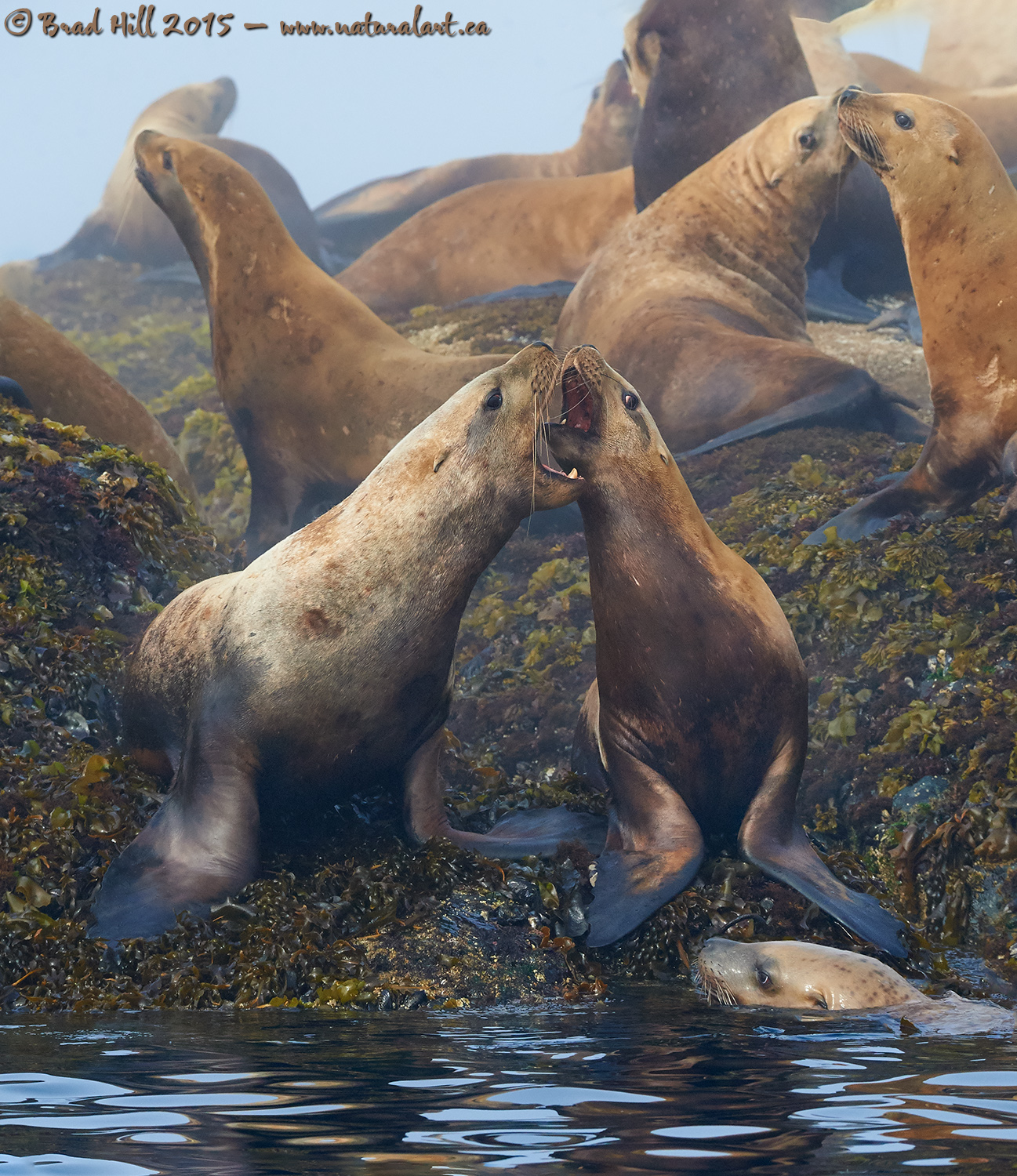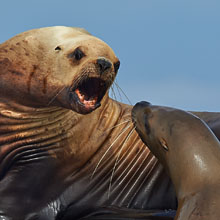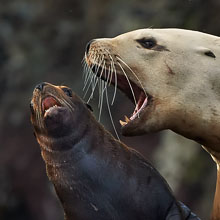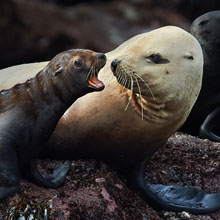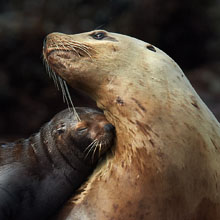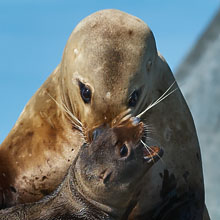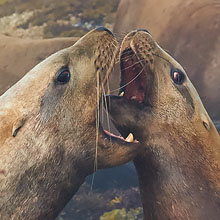Availability: Undetermined - Enquiries?
In the Field
The Spectator. Northern Vancouver Island region, BC, Canada. August 11, 2015.
Steller Sea Lions are highly gregarious animals and are often found in very high density settings (usually on or around haul-out rocks). This means they're continually in contact with other sea lions, and constantly having a variety of interactions with others. Some of the interactions are as benign as laying together with flippers casually draped over their "buddy's" back. Other interactions are a little more vigorous, such as one lion crawling right over others to get to "somewhere else" that suddenly has become desirable (interestingly, the sea lion being crawled over rarely seems to mind it). And, of course, you regularly get intense "in your face" interactions (like the one shown here) whenever two sea lions seem to want to occupy the same piece of turf. This minor dispute seemed to attract the attention of a third sea lion that swam over to watch proceedings. This spectator seems to think that UFC has nothing over his haul-out rock!
One of the biggest challenges of photographing sea lions at their colonies is to "sub-sample" the scene and pick out (and somehow isolate) some of the more interesting interactions. One approach is to open up your lens's aperture and throw the background out of focus, thus simplifying your composition. Lots of times this approach works well. In this case, however, I judged that even if I shot this at a wide aperture the background would be full of ugly, fat out-of-focus blobs (apologies to the sea lions, but a fact is a fact). So, I tried something a bit different with this shot...I used (and worked with) the heavy fog we had at the time to help isolate the main subjects. In short, during post-processing I used a form of contrast adjustment and applied it along a gradient from the foreground to the background (strongest contrast increase in the foreground AND on the two main subjects, tapering to no contrast increase at the top of the image).
A bit of background info is probably needed here. When we look at a foggy scene there's always a natural contrast gradient, with objects closest to us being most visible (and of highest contrast) and those further away being indistinct or literally disappearing (and of close to zero contrast). When we photograph such a scene some (and at times much) of the natural contrast gradient is lost, with the whole image looking flatter than we observed. The key to returning the scene to how it looked in the field is to increase the contrast of the closest objects and then continuously fade the contrast enhancement to zero "further back" in the image. Cutting fog or mist from foreground to background is quite easy and can be done with almost any image editing program or quality raw converter (the simplest method is to just redefine your black and white points using a Levels adjustment). The latest version of Lightroom (Lightroom 6, AKA Lightroom CC 2015 Release) has made this even easier (but dumbed down the controls a little) by adding their new Dehaze feature. But...the key to using contrast enhancement (using levels or Dehaze or whatever) to most accurately replicate what you saw in the field is to selectively apply the adjustment along a gradient. In this shot I chose to use my favourite raw converter (Phase One's Capture One Pro) and exported a few variants (that differed in the amount of contrast adjustment applied via a Levels adjustment) as 16-bit TIFF files, and THEN I blended the TIFF files in Photoshop CC 2015 (with a combination of a gradient mask from foreground to background and manual masking of the upper portions of the two main subjects). I know this might sound like Greek to some...but I suspect many will have an "Ahah!" moment after reading this...
For those wishing to see this image larger, here's a higher-resolution (2400-pixel) version for your perusal:
• The Spectator: Download 2400 pixel image (JPEG: 2.3 MB)
ADDITIONAL NOTES:
1. This image - in all resolutions - is protected by copyright. I'm fine with personal uses of it (including use as desktop backgrounds or screensavers on your own computer), but unauthorized commercial use of the image is prohibited by law. Thanks in advance for respecting my copyright!
2. Like all wildlife photographs on this website, this image was captured following the strict ethical guidelines described in The Wildlife FIRST! Principles of Photographer Conduct. I encourage all wildlife photographers to always put the welfare of their subjects above the value of their photographs.
3. This image was captured during my "Humpback, Orcas, Sea Lions & More" photo tour in August of 2011. Each year I offer trips into two different parts of the Great Bear Rainforest as well as one to photograph aquatic mammals and oceanscapes near the northern tip of Vancouver Island. And, in selected years, I also offer photo tours to locations to capture other highly sought-after subjects, such as various owl species of the boreal forest and wildlife of Canada's Arctic. Details about these trips can be found on the Photo Tours page of this website.
Behind the Camera
The Spectator. Northern Vancouver Island region, BC, Canada. August 11, 2015.
Digital Capture; Compressed RAW (NEF) 14-bit format; ISO 2500.
Nikon D4s paired with Sigma Sport 150-600mm zoom at 330mm. Hand-held from floating Zodiac inflatable boat; optical stabilization on and in OS1 mode.
1/1600s @ f10; no compensation from "recommended" matrix-metered exposure setting.
At the Computer
The Spectator. Northern Vancouver Island region, BC, Canada. August 11, 2015.
RAW Conversion to 16-bit TIFF using Phase One's Capture One Pro 8. Three raw variants (different versions of a single raw capture) processed, with the variants differing in exposure (0.3 stop total difference between the variants), noise reduction, and levels adjustments.
Further digital corrections on resulting 16-bit TIFF files using Adobe's Photoshop CC 2015 and Light Crafts Lightzone. Photoshop adjustments included compositing (blending) of the three output files from the raw converter using both gradient and manual masking techniques, several minor selective exposure adjustments, slight selective contrast adjustment via a selective curves adjustment, and selective sharpening for web output. Final tone-tweaking performed using LightZone's "tonemapper" tool.
Conservation
The Spectator. Northern Vancouver Island region, BC, Canada. August 11, 2015.
Ten percent of the revenue generated by this image will be donated to Raincoast*.
Species Status in Canada**: Special Concern (November 2003) - protected in Canada since 1970.
The Steller Sea Lion (Eumetopias jubatus) is the largest of the sea-lions, and males can weigh up to a ton (females are considerably smaller and rarely weigh over 600 lb). Males compete among themselves for females, and successful males end up breeding with several females within their harem.
From the early 1900's through to the 1970's huge numbers of Steller's Sea-Lions were culled for their fur and to remove a competitor (for humans) for salmon. During that time approximately 55,000 sea lions were killed and the breeding population of BC was lowered to about 4,000 animals. Since the Steller Sea Lion first received protection in 1970 the population in the coastal waters of BC has grown to between 18,000 to 19,700 animals (7,600 or so of these are of breeding age).
*The Raincoast Conservation Society (and Foundation) is an effective and efficient organization that has been fighting for protection of this unique habitat. If you are looking for a meaningful way to contribute to the conservation of this amazing ecosystem, Raincoast will provide maximal "bang" for your conservation dollars.
**as determined by COSEWIC: The Committee on the Status of Endangered Wildlife in Canada












